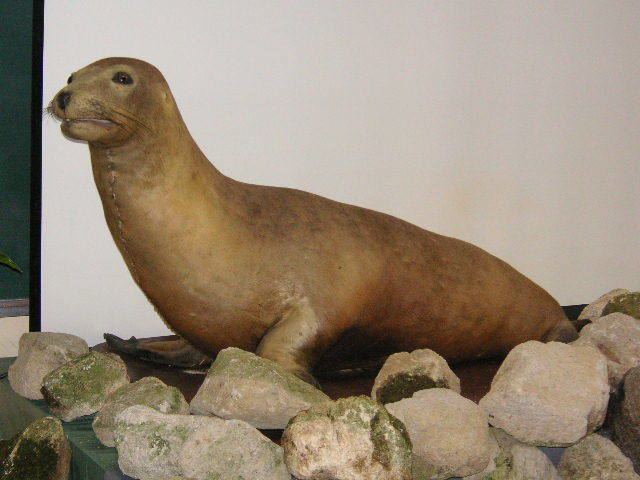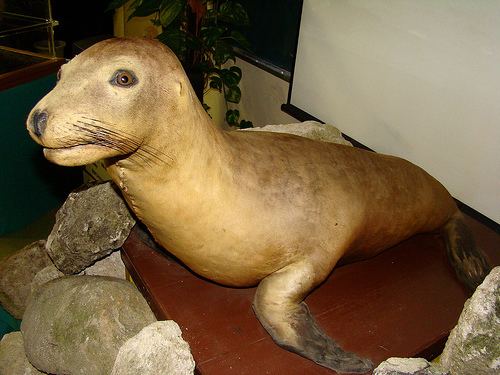Subfamily Otariinae Rank Species | Phylum Chordata Family Otariidae Genus Zalophus Higher classification Zalophus | |
 | ||
Similar Sea lion, Zalophus, California sea lion, Mammal, Galápagos sea lion | ||
J is for japanese sea lion
The Japanese sea lion (Japanese: ニホンアシカ, Hepburn: Nihon ashika, Zalophus japonicus) is an aquatic mammal thought to have become extinct in the 1970s.
Contents
- J is for japanese sea lion
- Japanese sea lion
- Physical description
- Range and habitat
- Lifestyle and reproduction
- Human uses
- Extinction
- Population revival efforts
- References

Prior to 2003, it was considered to be a subspecies of California sea lion as Zalophus californianus japonicus. However, it was subsequently reclassified as a separate species. Some taxonomists still consider it as a subspecies of the California sea lion. It has been argued that Z. japonicus, Z. californianus, and Z. wollenbaeki are distinct species because of their distant habitation areas and behavioral differences.

They inhabited the Sea of Japan, especially around the coastal areas of the Japanese Archipelago and the Korean Peninsula. They generally bred on sandy beaches which were open and flat, but sometimes in rocky areas.

Currently, several stuffed specimens can be found in Japan and in the National Museum of Natural History, Leiden, the Netherlands, bought by Philipp Franz von Siebold. The British Museum possesses a pelt and four skull specimens.
Japanese sea lion
Physical description

Male Japanese sea lions were dark grey and weighed about 450 to 560 kg, reaching lengths of 2.3 to 2.5 m; these were larger than male California sea lions. Females were significantly smaller at 1.64 m long with a lighter colour than the males.
Range and habitat
Japanese sea lions were primarily found in the Sea of Japan along the coastal areas of the Korean Peninsula, the mainlands of the Japanese Archipelago (both sides on the Pacific Ocean and Sea of Japan), the Kuril Islands, and southern tip of the Kamchatka Peninsula.
Old Korean accounts also describe that the sea lion and spotted seal (Phoca largha) were found in broad area containing the BoHai Sea, the Yellow Sea, and Sea of Japan. The sea lions and seals left relevant place names all over the coast line of Japan, such as Ashika-iwa (アシカ岩, sea lion rock) and Inubosaki (犬吠崎, dog-barking point) because of the similarity of their howls.
Lifestyle and reproduction
They usually bred on flat, open, and sandy beaches, but rarely in rocky areas. Their preference was to rest in caves.
Human uses
Many bones of the Japanese sea lion have been excavated from shell middens from the Jōmon period in Japan while an 18th-century encyclopedia, Wakan Sansai Zue, describes that the meat was not tasty and they were only used to render oil for oil lamps. Valuable oil was extracted from the skin, its internal organs were used to make expensive oriental medicine, and its whiskers and leather were used as pipe cleaners and leather goods, respectively. At the turn of the 20th century, they were captured for use in circuses.
Extinction
Harvest records from Japanese commercial fishermen in the early 1900s show that as many as 3,200 sea lions were harvested at the turn of the century, and overhunting caused harvest numbers to fall drastically to 300 sea lions by 1915 and to a few dozen sea lions by the 1930s. Japanese commercial harvest of Japanese sea lions ended in the 1940s when the species became virtually extinct. In total, Japanese trawlers harvested as many as 16,500 sea lions, enough to cause their extinction. Submarine warfare during World War II is even believed to have contributed to their habitat destruction. The most recent sightings of Z. japonicus are from the 1970s, with the last confirmed record being a juvenile specimen captured in 1974 off the coast of Rebun Island, northern Hokkaido.There were a few unconfirmed sightings in 1983 and 1985.
Sightings of single sea lions of unclear identities have been reported at Iwami, Tottori in July, 2003, and on the Koshikijima Islands in March, 2016. Both animals were positively identified as otariinae based on photographs.
Population revival efforts
In 2007, the South Korean Ministry of Environment has announced that South and North Korea, Russia, and China will collaborate on bringing back the Japanese sea lion in the Sea of Japan. The National Institute of Environmental Research of Korea was commissioned to conduct feasibility research for this project. If the animal cannot be found, the South Korean government plans to relocate California sea lions from the United States. The South Korean Ministry of Environment supports the effort because of the symbolism, national concern, the restoration of the ecological system, and possible ecotourism.
